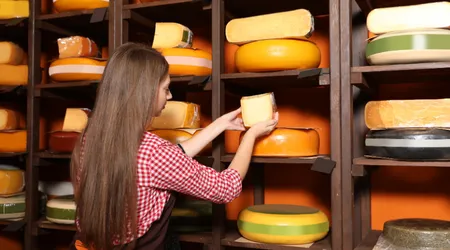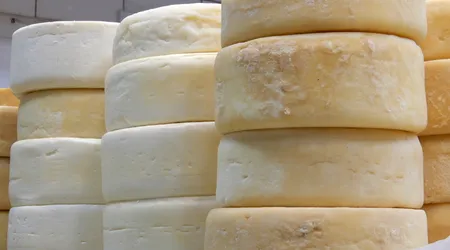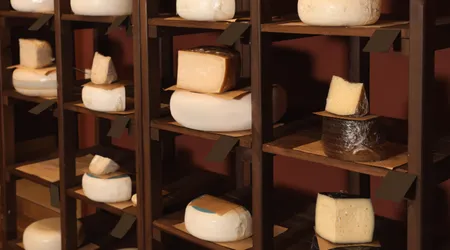How to store cheese correctly
Storing cheese properly is not just a matter of convenience, but an art that requires attention and knowledge.
Announcements
Each type of cheese, from soft mozzarella to aged pecorino, has unique characteristics that influence how it should be stored.
An error in storage can transform an artisanal product into a tasteless or, worse, inedible food.
In this guide, we'll explore advanced techniques, debunk common myths, and provide practical tips to ensure your cheese retains its texture, aroma, and flavor.
Because, after all, who wouldn't want to taste every bite as if it were freshly bought?
Announcements
Get ready to discover how to properly store cheese with intelligence and creativity.
1. Understanding the Needs of Cheese: A Science Behind Preservation

To properly store cheese, you must first understand its nature.
Cheeses are living products, constantly evolving thanks to bacteria, molds, and chemical processes.
A fresh cheese like ricotta has a high moisture content, making it more susceptible to bacterial growth, while an aged cheese like Parmigiano Reggiano is more stable but susceptible to flavor loss.
++ Mise en Place in the Home Kitchen: The Art of Cooking Efficiently
Therefore, conservation must respect these differences.
For example, an environment that is too dry can cause a hard cheese to crack, while one that is too humid can encourage unwanted mold on a soft cheese.
An often overlooked aspect is temperature.
According to a study by the University of Parma, consumers store cheese at temperatures that are too low (below 4°C), compromising its molecular structure and altering its taste.
The ideal temperature varies: 4-8°C for fresh cheeses, 8-12°C for aged cheeses. Furthermore, exposure to air is a critical factor.
Oxygen can accelerate the oxidation of fats, causing rancid flavors.
For this reason, wrapping the cheese in breathable materials, such as cheese paper, is essential for balancing humidity and ventilation.
Finally, consider the analogy of cheese as fine wine.
Just as a good Chianti requires a cellar with specific conditions, cheese requires a controlled microenvironment.
You wouldn't leave it in any old pantry, exposed to sudden temperature changes, right?
Likewise, properly storing cheese means creating a habitat that preserves its integrity, enhancing the work of cheesemakers and affineurs.
| Type of cheese | Ideal temperature | Winding material | Maximum duration |
|---|---|---|---|
| Fresh (e.g. Mozzarella) | 4-6°C | Cheese paper or airtight container | 5-7 days |
| Semi-mature (e.g. Fontina) | 8-10°C | Breathable cheese paper | 2-3 weeks |
| Aged (e.g. Pecorino) | 10-12°C | Waxed paper or cotton cloth | 1-2 months |
2. Practical techniques for correctly storing cheese

Now that we know the scientific basis, let's move on to practice.
A common mistake is wrapping cheese in plastic wrap.
While it may seem like a convenient solution, plastic retains moisture, creating an environment favorable to bacteria and mold.
++ Ideal temperature for homemade pizza
Instead, opt for cheesecloth, a material designed to allow for breathability.
Alternatively, a slightly dampened cotton cloth can be a great choice for aged cheeses, as it retains moisture without suffocating them.
An original example?
Try storing Gorgonzola in a glass container with a small piece of apple.
Apples release ethylene, a gas that helps control the growth of unwanted mold, preserving the creamy flavor of the cheese.
Make sure, however, to change the apple every 2-3 days.
This little-known method is a trick used by some cheesemakers to keep blue cheeses in optimal condition.
Also, avoid storing different cheeses in the same container without separating them: the intense aromas of a Roquefort can easily contaminate a delicate Brie.
Another smart tip is to label your cheeses.
Write the purchase date and the type of cheese on a sticker before wrapping it.
This not only helps you monitor freshness, but allows you to plan consumption based on shelf life.
For example, a Camembert reaches its peak flavor within 10-14 days of purchase, while a Grana Padano can last for months if stored properly.
Little touches like these make the difference between an average cheese and an extraordinary one.
Table:
| Preservation method | Advantages | Disadvantages | Suitable for |
|---|---|---|---|
| Cheese paper | Breathable, moisture wicking | Slightly higher cost | All cheeses |
| Plastic film | Economical, easy to use | Promotes mold | Not recommended |
| Glass container | Reusable, protects from odors | Bulky | Soft cheeses |
| Cotton cloth | Economical, breathable | Requires maintenance | Aged cheeses |
3. Mistakes to avoid when storing cheese

Storing cheese correctly also means knowing what Not Do.
One of the most common mistakes is leaving cheese in its original packaging, which is often unsuitable for long-term storage.
Vacuum-packed packages, for example, are excellent for transport, but once opened, the cheese needs to “breathe”.
Leaving it in a plastic bag at the supermarket is like trapping it in a sauna: moisture builds up, compromising its quality.
Another serious mistake is freezing.
While it may seem like a solution to extend the shelf life of cheese, extreme cold alters the structure of proteins and fats, making soft cheeses watery and hard cheeses crumbly.
A practical example: I once tried freezing a slice of Taleggio, hoping to enjoy it months later. The result?
A grainy texture and a dull flavor, far from the original.
If you absolutely must freeze, only do so with hard cheeses like Pecorino, grating them first for later use in cooking.
Finally, don't underestimate the importance of its location in the refrigerator.
Storing cheese in the vegetable drawer, as many do, is a mistake.
This area is often too humid and cold, unsuitable for most cheeses.
Instead, choose a central compartment, where the temperature is more stable.
By avoiding these mistakes, you not only prolong the life of your cheese, but you also enhance its organoleptic qualities.
| Common mistake | Consequence | Solution |
|---|---|---|
| Use of plastic film | Mold, altered flavors | Cheese paper |
| Freezing | Compromised texture | Consume fresh or grate |
| Storage in the vegetable drawer | Excessive humidity | Central refrigerator compartment |
4. How to handle cheese in non-ideal conditions

Not everyone has a dedicated cheese cellar or refrigerator, but that doesn't mean you can't store cheese properly.
In less than perfect situations, such as a hot kitchen or a trip, it is possible to adopt creative solutions.
For example, if you're camping, wrap the aged cheese in a cotton cloth moistened with apple cider vinegar.
Vinegar creates a natural barrier against bacteria, keeping cheese safe for 12-24 hours without refrigeration.
Another common scenario is storage during a blackout.
++ Balancing Flavors in a Dish: The Art of Harmonious Cooking
If your refrigerator stops working, transfer the cheeses to a cooler with a cool, damp cloth.
Add a small container of cold water to stabilize the temperature.
This method can keep cheeses fresh for several hours, giving you time to consume them or find a solution.
Also, for soft cheeses, consider spreading them on croutons or using them in instant recipes, reducing waste.
Flexibility is key. If you live in a hot, humid climate, invest in micro-perforated containers that allow for ventilation without leaving the cheese exposed.
These measures demonstrate that, with a little ingenuity, it is possible to overcome adverse conditions and continue to enjoy cheese to its full potential.
| Emergency solution | Duration | Suitable for |
|---|---|---|
| Apple cider vinegar cloth | 12-24 hours | Aged cheeses |
| Cooler bag with damp cloth | 6-12 hours | All cheeses |
| Micro-perforated container | 1-2 days | Soft cheeses |
5. Frequently asked questions regarding the preservation of that item
| Dúvidas frequentis | Answer |
|---|---|
| Can I store different cheeses in the same container? | Yes, but separate them with cheese paper to avoid contamination of the aromas. |
| How long can I leave cheese out of the fridge? | No more than 2 hours at room temperature (20-25°C) to avoid bacterial proliferation. |
| Is mold on cheese always dangerous? | No, as bolachas our molds of those soft (e.g. Gorgonzola) are many times beneficial, but also as bolachas our hard molds** (e.g. Chetar) modem ber um Sinai de deterioracelo. Always remove the affected part with a margin of 1 cm. |
| Can I reuse cheese paper? | |
| Why does my cheese taste bitter? |
Concluded
Storing cheese properly is a process that combines science, practice, and creativity.
From choosing the wrapping material to managing less than ideal situations, every detail counts in preserving the quality of this extraordinary food.
With the right techniques, you not only extend the shelf life of your cheese, but you also enhance its flavor, turning every tasting into a unique experience.
Now that you have all the necessary knowledge, you are ready to store your cheeses with the care they deserve.
What will be the next cheese you will preserve perfectly?
